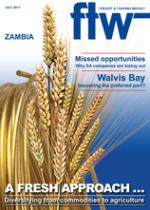After nearly 50 years of
independence from Britain,
Zambia is starting to flex
its economic muscle, and move
beyond being a commoditiesreliant
economy.
At the peak of copper
production in the mid-1970s,
Zambian per capita incomes were
four times higher than per capita
income of Malawi, Tanzania and
Zaire.
At that time, Zambia was the
largest producer of copper in the
developing world and the third
largest in the world.
Production dropped from the
high of 700 000 tons in 1976 to
249 100 tons in 2000, when the
government decided to privatise
the industry.
There has been steady
investment over the past 10 years,
affected by cyclical falls in the
copper price.
Production this year is expected
to exceed 800 000 tons, according
to the Zambian Central Bank.
Zambia is adding value to its
raw materials through the export
of copper in the form of cathodes
or blisters rather than concentrate.
An example is the Chineseowned
Chambishi Copper
Smelter, which is investing
US$250 million to double its
blister production capacity of
150 000 tons a year.
Chambishi Copper Smelter
deputy chief executive officer
Fan Wei told Steel Guru that the
increase in its annual production
capacity to about 300 000 tons
of blisters and 340 000 tons of
sulphuric acid was expected to
satisfy rising demand. Chambishi
is using “state of the art ISA
technology” from Australia,
and expects to achieve a copper
recovery rate of 98%.
The revival of the copper
industry is having a knockon
effect on agriculture,
manufacturing and real estate.
Logistics, shipping and clearing
companies attracted by the glitter
of copper have started looking for
new business, and are working
with farmers and their associations
to open up new markets.
Where trade lanes are opened,
business begins to flow.
So much so that Zambia is
positioning itself as the “hub” for
Central African trade.
One disappointment so far has
been the revival of the Central
and East African trading bloc.
Significant investment is needed
in the manufacturing sector of the
region before it can start trading
with itself.
A start is being made in Zambia,
with much excitement and pride
in the capital Luanda about the
opening of a US$15-million earth
moving equipment assembly plant
by Hitachi.
Situated on the main road from
the airport into town, it makes a
statement about new business and
opportunities.
The plant will supply the region,
and is the first investment into the
Zambian manufacturing sector by
a Japanese company.
Speaking at the ground-breaking
ceremony, Japan’s ambassador
to Zambia, Akio Egawa, said his
government was encouraging
investment in the country. “We
have stepped up our efforts to
encourage Japanese businesses to
do business and invest in Zambia.”
Vehicle assembly is also set to
return to Zambia, with China’s top
bus manufacturing company Higer
announcing that it is to build a
plant to serve the Southern African
region.
High-tech investment has
come in the form of the country’s
first mobile phone assembly
plant, which is a US$10-million
investment by MMobile, a
member of the Melcome Group.
There is also a continuing
construction boom in the country,
with new malls, offices and hotels
being built.
Liberty Properties, together
with the Zambia National Pension
Scheme Authority, is creating the
largest mixed-use development of
its kind in Zambia.
Phase 1 of the US$ 200-million
Levy Park mixed-use development
is expected to be completed in
October this year.
The 30 000sq m retail precinct is
Zambia’s first fully enclosed mall.
A 150-room Stay Easy Hotel
is a key feature of the new
development, while a five-floor
office component is billed to
become Zambia’s most desirable
corporate address.
This will be followed by future
retail (Phase 2) and a residential
element (Phase 3).
Zambia starts flexing economic muscle
22 Jul 2011 - by Ed Richardson
0 Comments
Zambia 2011

22 Jul 2011
22 Jul 2011
22 Jul 2011
22 Jul 2011
22 Jul 2011
Border Beat
Featured Jobs
New
New
New
